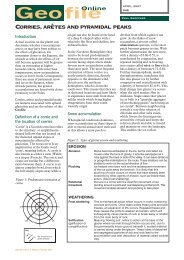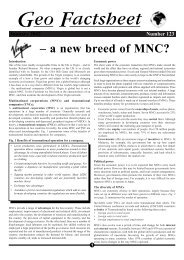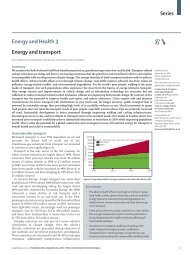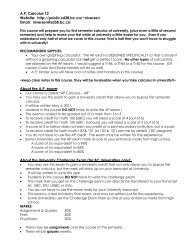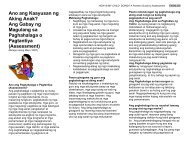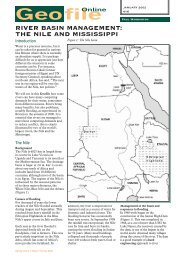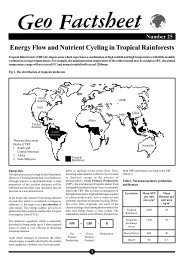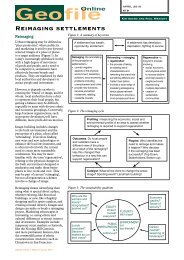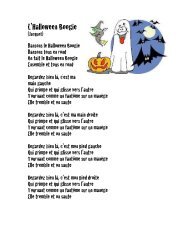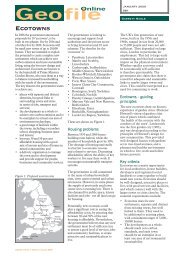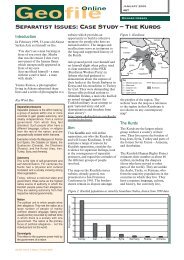80 Antartica.pdf - Richmond School District No. 38
80 Antartica.pdf - Richmond School District No. 38
80 Antartica.pdf - Richmond School District No. 38
Create successful ePaper yourself
Turn your PDF publications into a flip-book with our unique Google optimized e-Paper software.
Antarctica<br />
Geo Factsheet<br />
or recognised by countries such as the United States. The 1959 Antarctica<br />
Treaty actually preserved the positions of the seven nations claiming<br />
territory in Antarctica and the nations that do not recognise territory claims.<br />
In practice this means that every decision or agreement which is put forward<br />
is extremely carefully negotiated so that it does not prejudice either group's<br />
legal position.<br />
Antarctica is administered through annual consultative meetings of the<br />
signatories to the Treaty. A range of articles and agreements have been<br />
made (Fig 3).<br />
Fig 3. Major Treaties and Articles<br />
1959 Antarctica Treaty - 12 countries took part in the 1957/58<br />
International Geophysical Year. These are the original 12<br />
signatories.<br />
1972 Convention for the Conservation of Antarctic Seals<br />
19<strong>80</strong> Convention on the Conservation of Antarctic Marine Living<br />
Resources (CCAMLR)<br />
1988 Convention on the Regulation of Antarctic Mining Resource<br />
Activities (CRAMRA)<br />
Major Articles<br />
1. Area to be used for peaceful purposes only, military activity<br />
is prohibited<br />
2. Free development of scientific investigation and co -operation<br />
3. Free exchange of information and personnel between the UN and<br />
other investigative agencies<br />
4. Territory claims will not be established, recognised or disputed<br />
5. Prohibition of nuclear experiments or disposal of radioactive<br />
wastes<br />
6. The treaty includes all land and ice shelves south of 60 0 00'<br />
south<br />
7. Treaty signatories have free access to each other's stations<br />
8. Treaty signatories will discourage actions by any country in<br />
Antarctica that are contrary to the treaty<br />
9. Disputes to be settled peacefully<br />
A number of conventions, acts and protocols also serve to protect various<br />
aspects of the continent’s wildlife.<br />
The Protocol on Environmental Protection to the Antarctic Treaty<br />
came into force in January 1998 and protects the Antarctic environment<br />
against marine pollution and any threats to flora and fauna. It also prohibits<br />
all actions related to mining except scientific research.<br />
Conflicts in Antarctica<br />
Antarctica faces a number of threats (Fig 4).<br />
Fig 4. Conflicts in Antarctica<br />
oil<br />
exploration<br />
mineral<br />
exploration<br />
fishing<br />
research<br />
scientists<br />
tourism<br />
long-range<br />
air pollutants<br />
destruction of stratospheric<br />
ozone allows ultraviolet through<br />
1. Tourism Antarctica receives 12000 visitors annually. Tourism is now<br />
the second largest commercial activity after fishing (Fig 5).<br />
Fig 5. Estimated annual number of tourist visitors to Antarctica<br />
(1956-1996)<br />
Most activity is concentrated in two areas:<br />
1. Antarctica peninsula<br />
2. South Georgia<br />
Access to both areas is largely determined by the pack ice and the major<br />
attractions are the wildlife to be seen.<br />
Impact:<br />
• disturbance to wildlife e.g. through breeding season<br />
• introduction of bird and mammal diseases<br />
• destruction of historical sites<br />
• disposal of waste from cruise ships.<br />
Attempts are being made to try to persuade tourists to visit with tour<br />
operators who are members of The International Association of<br />
Antarctic Tour Operators, one of whose duties is to promote safe and<br />
environmentally responsible travel to the area.<br />
Stratospheric ozone<br />
The stratospheric ozone hole was first discovered in Antarctica. In<br />
1999 the area of thinning of the ozone layer over Antarctica (the<br />
ozone hole) was the largest ever - 29 million km 2 . The extent of the<br />
thinning is largely determined by the concentration of chlorine in the<br />
atmosphere which has been formed from CFCs (Fig 6). Increased<br />
ultraviolet radiation has damaged the DNA of ice fish and phytoplakton<br />
- the latter are the basis of all food chains in the region. The discovery<br />
of Antarctica’s ozone hole led to the Montreal Protocol which has<br />
dramatically decreased CFC production and use.<br />
Fig 6. Stratospheric ozone and chlorine concentration<br />
ozone concentration (dobson units)<br />
number of tourists (thousands)<br />
400<br />
300<br />
200<br />
100<br />
9<br />
8<br />
7<br />
6<br />
5<br />
4<br />
3<br />
2<br />
1<br />
0<br />
1956<br />
ozone<br />
1966<br />
1976<br />
years<br />
1986<br />
chlorine<br />
0<br />
1950 1960 1970 19<strong>80</strong> 1990 2000<br />
year<br />
1996<br />
Atmospheric chlorine (ppbv)<br />
2



